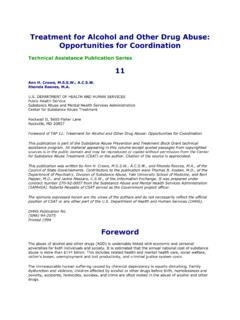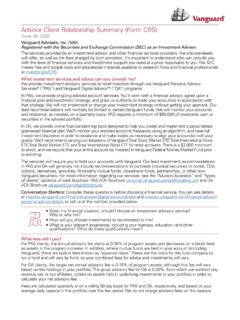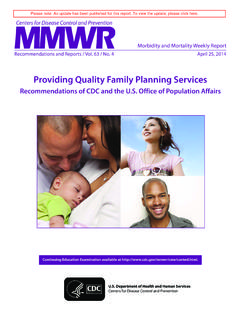Transcription of Counselor's Manual for Relapse Prevention With Chemically ...
1 Counselor's Manual for Relapse Prevention With Chemically Dependent Criminal Offenders Technical Assistance Publication (TAP) Series 19. DHHS Publication No. (SMA) 96-3115. Printed 1996. DEPARTMENT OF HEALTH AND HUMAN services . Public Health Service Substance Abuse and Mental Health services Administration Rockwall II, 5600 Fishers Lane Rockville, MD 20857. Introduction This publication is intended for use by people who are interested in working with criminal offenders who are Chemically dependent (addicted to alcohol and/or drugs). It focuses on chemical dependency and the criminal offender, and will present you with information you may not have been exposed to before. Research tells us that most criminal offenders have alcohol or drug problems. It also tells us that traditional forms of treatment for chemical dependency are not very successful with these offenders. Many of them return to using alcohol or drugs after treatment. When this happens, most of them become repeat offenders.
2 This publication is designed to help you teach criminal offenders how they can stay sober and clean. This publication is designed for the paraprofessional counselor. A paraprofessional counselor is someone who wants to help others, but who has little or no professional counselor training. This publication explains basic counseling information in simple terms. It is also designed to help you work with people who are using the Appendix Relapse Prevention Workbook for Chemically Dependent Criminal Offenders. It explains the purpose of each exercise in this workbook and tells you how to help the patient use and understand the exercises. This publication is based on information that has had better than average results in treating Chemically dependent criminal offenders. This information is called Relapse Prevention therapy. Relapse Prevention therapy is based on experience with patients who generally fail in traditional treatment. The techniques in this publication were developed through experience with these patients.
3 Relapse Prevention therapy breaks down the recovery process into specific tasks and skills. Patients must learn these skills in order to recover. It also shows patients how to recognize when they are beginning to Relapse , and how to change before they start using alcohol or drugs again. It is important that you read the entire publication to understand the basic information and how it all fits together. When you read the section that explains how to use the exercises from the Appendix Relapse Prevention Workbook for Chemically Dependent Criminal Offenders, read the workbook at the same time. If you are a recovering person yourself, fill in the workbook as you go through it. This will help you understand how the exercises work. It is important to tell your patients (the offenders with whom you are working) that they may get frustrated or discouraged at times when they are completing the workbook. The main reason for this is that Chemically dependent people, especially criminal offenders, want immediate payoffs and results.
4 Recovery doesn't give immediate results. Encourage them to continue with the exercises, and give them positive feedback for each step they complete along the way. It is also important for you not to get discouraged. Talk with other people who are doing the same kind of work. Find out what is working and what is not working for them. Tell them the same things. Encourage one another. How will you know when patients are making progress? You will know by seeing how they change the way they think, feel, and act toward themselves and others. If you try to control your patients, they will either drop out of treatment or simply manipulate you by telling you what they think you want to hear. It is important that you view your patients as people whose disease of chemical dependency and way of thinking prevent them from acting in a socially acceptable manner. These patients may want to be full members of society, but they do not have the skills to do so. In some cases, they have given up hope.
5 It is your job to help your patients understand more about themselves and the world, help them learn new skills, and give them hope, so that they are motivated to change. You cannot do this by telling them what they are or what they must be. It is one thing for you to know, but unless the patient comes to an understanding based on changes in his or her own thinking, treatment will fail. You do not have all the answers. Even professional counselors do not have all the answers. Most answers come from listening carefully to what patients say and how they think. If you do not know something, be honest. Patients will respect you for this and be more willing to work with you if you are honest about what you do and don't know. When you don't know an answer, try to find the information and share it with the patient. Most of all, give patients your best effort. If you do this and learn from your mistakes, you will become a better counselor. Read as much as possible about chemical dependency and counseling for Chemically dependent people.
6 Get all the training you can. Remember, your best source of information is your patients. When you make a mistake, admit it and learn from it. Even if you don't succeed with one patient, what you will learn will help other patients in the future. You may never know for sure if you have helped most of your patients. Some patients will not use information you give them now, but will use it at some point in the future. Also, remember that every patient you help will have a positive impact on everyone with whom they come in contact. Part I: General Information on Drug and Alcohol Dependency, Recovery, and Relapse Chapter 1 What is Chemical Dependency/Addiction? Chemical dependency is a disease caused by the use of alcoholand/ or drugs, causing changes in a person's body, mind, and behavior. As a result of the disease of chemical dependency, people are unable to control the use of alcohol and/or drugs, despite the bad things that happen when they use. Chemical dependency occurs most frequently in people who have a family history of the disease.
7 As the disease process progresses, recovery becomes more difficult. Chemical dependency may cause death if the person does not completely abstain from using alcohol and other mood-altering drugs. Effects The problems of chemical dependency that affect people when they use alcohol or drugs, and even after they have stopped using, include the following. Malnutrition and metabolic dysfunction. The addict's ability to function normally is damaged by the effects of alcohol and/or drugs on the brain and body. Only after a period of proper diet and taking supplements can normal body chemistry be restored. This process affects the way the addict thinks, feels, and acts. Liver disease and other medical complications. The addict's liver enzymes may be far above normal. This can cause poisonous effects within the body and may lead to infections and illnesses that need to be treated before normal functioning can resume. Brain dysfunction. Alcohol and drugs damage brain cells, interrupt the production of certain brain chemicals called neurotransmitters, and alter the way the brain functions.
8 Some of these changes may be permanent. Addictive preoccupation. A Chemically dependent person's thinking patterns are altered by chemical dependency as the disease progresses. These changes cause the person to have strong thoughts, desires, and physical cravings for alcohol or drugs. These processes also change the way the person sees the world. They lead the person to believe that using is better than not using, despite the bad things that result from using. Social consequences. As the physical and psychological problems identified above get worse, the person's behavior becomes more antisocial and self-destructive. Frequent social consequences of addiction are job loss, money problems, car accidents, domestic violence, criminal behaviors, illness, and death. Criminal behaviors. Chemical dependency can cause a person to commit crimes. People who are Chemically dependent commit crimes related to their use of alcohol or drugs (drunk driving, public drunkenness, assault, etc.)
9 , the support of their addiction (selling drugs, committing crimes to get drugs or money for drugs, etc.), and secondary consequences of drug or alcohol use (not paying child support or court fines, failing to follow through with probation requirements, etc.). Some people do not commit crimes until they become Chemically dependent. Others have personality problems that initiate their criminal behavior. Most of those who have personality problems either become Chemically dependent on or abusive of alcohol and drugs. Any Relapse into behavior that leads to criminal actions is likely to cause a Relapse into the use of alcohol or drugs. Any Relapse into chemical use is likely to cause a Relapse into criminal behavior. The conditions just described combine and interfere with the ability to think clearly, control feelings, and regulate behaviors, especially under stress. Alcohol and drug dependency damages the basic personality traits that are formed before the addictive use of alcohol or drugs.
10 Dependency on alcohol or other drugs systemically destroys meaning and purpose in life as the addiction gets worse and worse. Treatment Because dependency on alcohol or other drugs creates problems in a person's physical, psychological, and social functioning, treatment must be designed to work in all three areas. The worse the damage in each area, the greater the chance of Relapse and return to old behaviors (criminal actions and/or the use of alcohol or drugs). Total abstinence (not using any alcohol and drugs) plus personality and lifestyle changes are essential for full recovery. The type and intensity of treatment depend on the patient's: Current physical, psychological and social problems Stage and type of addiction(s). Stage of recovery Personality traits and social skills before the onset of addiction Other factors in life that cause stress. Chemical dependency is a chronic condition that has a tendency toward Relapse . Abstinence from alcohol and other mood-altering drugs is essential in the treatment of chemical dependency.









